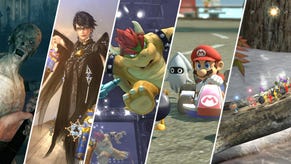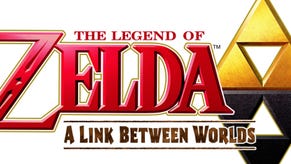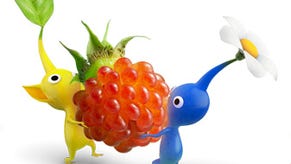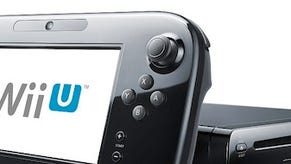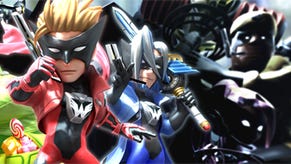2013 in Review: Pikmin 3 Puts a Friendly Face on Video Game Violence
Nintendo's strategy adventure was as brutal and violent as any video game in 2013. So why doesn't it seem as off-putting?
This article first appeared on USgamer, a partner publication of VG247. Some content, such as this article, has been migrated to VG247 for posterity after USgamer's closure - but it has not been edited or further vetted by the VG247 team.
I am not, as a rule, a fan of violence in video games.
This isn't to say I'm some hand-wringing puritan who refuses to touch a game with guns. On the contrary, I enjoy a good shooter every now and then. But more is almost always less when it comes to digital murder, and I find myself put off by games that revel in mindless, graphic brutality as well as those that try to tell a thoughtful human story within a framework consisting of constant, by-the-numbers slaughter.
So why, then, was one of the most compelling games I reviewed this year also one of the most violent I've ever played? For some reason, even though Pikmin is as vicious a game as I can name, its foundation of wholesale conflict and killing doesn't bother me in the least. In fact, I find it practically intoxicating.
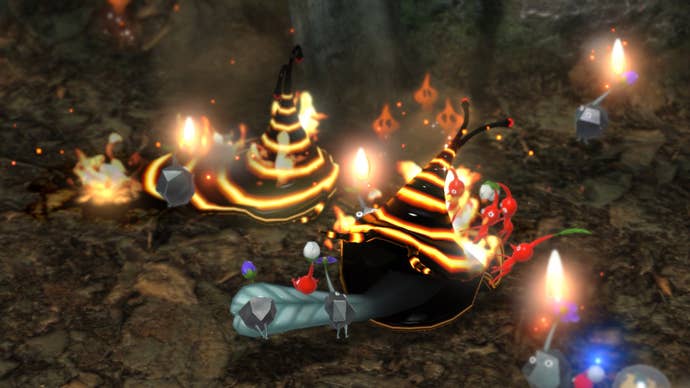
Maybe it's the art style. Pikmin 3 may be the single most photorealistic video game I've ever played -- its environments look stunningly convincing. It's a world in miniature, a tour of a post-apocalyptic earth experienced at a macro scale. Every plant, every rock, and every abandoned human artifact has been crafted with exacting care. The end-of-day synopses in which your team tallies up the latest haul of fruit before pulping each item into juice inevitably makes my mouth salivate at the exquisite detail invested in those perfect renditions of perfect morsels. Only Pixar's Ratatouille has managed to make computer-rendered food more appetizing.
Yet within the game's gorgeously mundane world, the creatures going to war with one another look decidedly unreal. It makes for a fascinating approach to dealing with the uncanny valley: Pikmin presents the stuff that's easy to make look realistic -- scenery -- as intensely true-to-life as possible. Rather than populate this trompe-l'oeil universe with not-quite-convincing denizens of the real world, though, Nintendo instead crams it full of pop-eyed critters that draw upon familiar touchstones -- common bugs, plants, and animals -- yet which don't seem to demonstrate much interest in looking lifelike. Bulborbs may well be enormous ladybugs mutated nearly beyond recognition, but they wobble comically as they bear down on your team, their exaggerated movements crafted for expression, not simulation.
Like its predecessors, Pikmin 3 represents Nintendo's foray into real-time strategy, and you'll find many of the familiar touchstones of the RTS genre here: Team management, combat, multitasking, resource-gathering, venturing forward to push back the fog of war. However, the series' macro-lens perspective on things gives it a very different feel from the typical RTS; you're not conquering a planet or engaging in some holy war but instead simply gathering fruit to take back to a starving populace. You can't summon screen-clearing nuclear attacks via satellite or build factories in the enemy's territory; instead, you concern yourself with such gripping tasks as building bridges across puddles by gathering shards of ceramic tile or finding ways to collect a stranded lemon surrounded by hungry tadpoles.
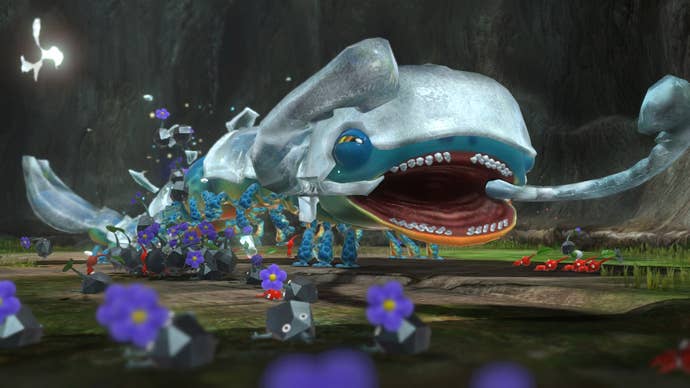
The nature-themed aesthetic of Pikmin 3 makes its violence seem, well, natural. At a very basic level, you're leading an army of up to 100 followers who have to destroy enemies through constantly melee combat. Aside from the very occasional opportunity to detonate tiny rock-bombs near foes, the bulk of battles in Pikmin 3 transpire at a very up-close and personal range. You throw your tiny minions at vast, outsized monsters so they can pummel their targets to death, and only through persistence and sheer numbers do you have a chance of winning.
Pikmin 3's take on nature is nature red in tooth and claw; it feels like the proper order of things for your walking vegetable men to fight back against the predation of the world's roaming monsters. The titular pikmin are inch-high creatures, strange plant-animal hybrids, and they make a perfect snack for the animals living in Pangaea's ruins. Giant bugs can crunch them. Birds can gulp a dozen of them with a single scoop of their beak. Larger creatures barely even acknowledge the pikmins' presence, crushing your precious helpers almost by accident as they stomp around. Simply traveling from place to place represents harrowing danger, simply because that's how nature works.
This context lends the conflict in Pikmin a different flavor from typical video game violence. It's not about the usual excuses to fight -- politics, greed, boredom -- but rather a matter of fundamental survival. Despite the pastoral setting and lovely tilt-shift macro presentation, Pikmin 3 is underpinned by a need to subsist. Your alien astronauts need to harvest food both to replenish their planet's global larder and to keep them alive for their current quest; the world's creatures need to chomp down on tasty pikmin in order to thrive; and your pikmin need to fight back in order not to end up as a little bit of food stuck between some Bulborb's front teeth.
And you sure don't want that. See, Pikmin 3 also succeeds by placing emotional weight on the outcome of a badly waged battle. While you'll find it easier to grow and harvest pikmin here than in past games, the little guys still represent both a limited resource and a flock of lovable companions. Losing a squad of them as the result of an ill-advised sally into dangerous territory doesn't simply diminish your astronauts' capacity to go adventuring, it also breaks your heart. Each vanquished pikmin expires with a wrenching cry followed by tiny its little pikmin ghost ascending to the heavens. They're not simply resources; they're companions.
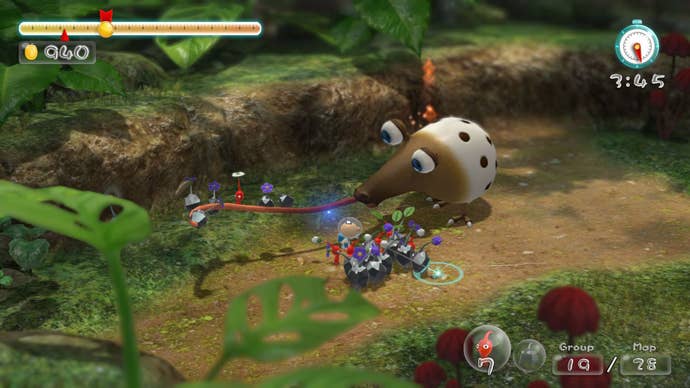
Nintendo's designers used every cheap trick in the book to make you love your pikmin. With their bulbous heads and enormous eyes on stubby-limbed bodies, they're neotony in action. Every sigh they emit, every cry they shriek hits you right in the part of your soul that's hard-wired to instinctively protect infants. Their obedience and gleeful love for mayhem (not to mention their tendency to get distracted by nearby shiny objects) fosters the sensation that you're commanding an army comprised of dozens of your own children. The act of "birthing" them further cements the illusion; pikmin are not shuttled in from elsewhere or mass-manufactured in robot factories as in other RTS games. Instead, you direct their creation, actively commanding a team of followers to break off and take resources back to the "onion" where pikmin are born as seeds. And once those seeds have taken root, you then manually pluck them from the ground; even though Pikmin 3 applies a touch of automation to the process, you still take part in the entire creation cycle of every member of your army, from "conception" to "birth."
And so, when you lose a squad of pikmin to a hungry lobster-thing's crushing mandibles and slobbery tongue, or to the errant footstep of a muck-dwelling rock-beast, you'll often be tempted to restart the current day of the adventure and try over. Not because you've lost a strategic resource; you probably have dozens if not hundreds of replacements. Rather, because the sight of those shimmering ghosts ascending to the heavens with a plaintive cry punches you right in the heart. Because you can't stand the thought of being such a terrible caretaker to these stupid little creatures that you'd willingly let them die so easily. And the game takes every opportunity to remind you of your failings as a pikmin parent, ending each day with a chart showing the growth (or shrinkage) of your army. Nothing in Pikmin 3 makes you feel like so much of a failure as a massive downward spike on the daily graph.
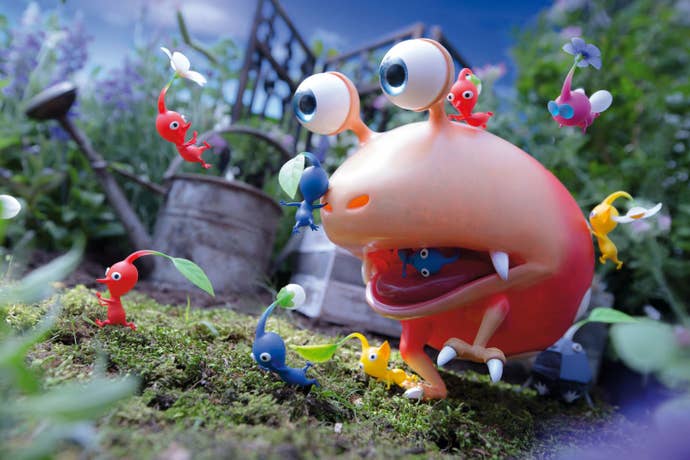
What really gels it all is the fact that while you don't view your followers as mere resources, Pikmin 3 really does work on a mechanical level -- and it works brilliantly at that. The different varieties of pikmin you gather and grow each serve different functions within the game, and as you add new types of followers to your army you gain the ability to venture ever further into the world. Pikmin 3 gates progress with a number of barriers, yet it allows you a liberating freedom of exploration. You can venture into its gorgeous world at your leisure (provided you harvest enough juice along the way to keep your astronauts fed), and you can complete your mission as casually or efficiently as you choose.
So when your team of pikmin brutally takes down a monster hundreds of time their size, you don't think about how horrible it is that you were the one who invaded that creature's lair in order to plunder its bounty of fruit. You don't consider the underlying ramifications of your colonial invasion, or the fact that in teaching a peaceful native species to kill you're surely violating some kind of Prime Directive. You don't think how bloody and violent video games are, either. No, you feel parental pride -- a swell in your heart to see your little ones getting along so well.

